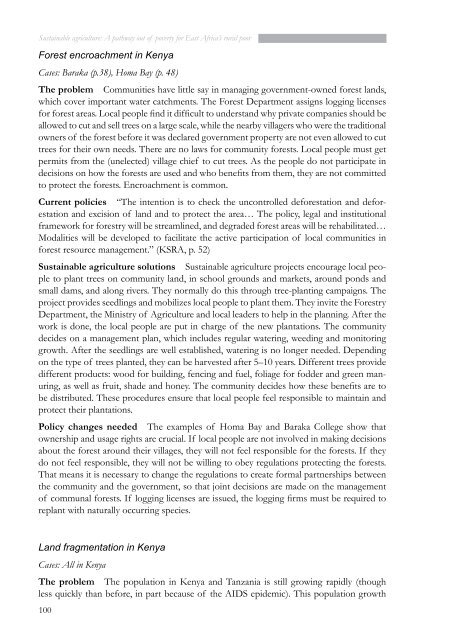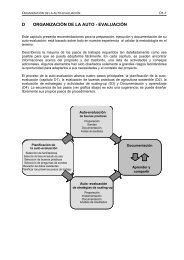cases from tanzania - Sustainet
cases from tanzania - Sustainet
cases from tanzania - Sustainet
Create successful ePaper yourself
Turn your PDF publications into a flip-book with our unique Google optimized e-Paper software.
Sustainable agriculture: A pathway out of poverty for East Africa’s rural poor<br />
Forest encroachment in Kenya<br />
Cases: Baraka (p.38), Homa Bay (p. 48)<br />
The problem Communities have little say in managing government-owned forest lands,<br />
which cover important water catchments. The Forest Department assigns logging licenses<br />
for forest areas. Local people find it difficult to understand why private companies should be<br />
allowed to cut and sell trees on a large scale, while the nearby villagers who were the traditional<br />
owners of the forest before it was declared government property are not even allowed to cut<br />
trees for their own needs. There are no laws for community forests. Local people must get<br />
permits <strong>from</strong> the (unelected) village chief to cut trees. As the people do not participate in<br />
decisions on how the forests are used and who benefits <strong>from</strong> them, they are not committed<br />
to protect the forests. Encroachment is common.<br />
Current policies “The intention is to check the uncontrolled deforestation and deforestation<br />
and excision of land and to protect the area… The policy, legal and institutional<br />
framework for forestry will be streamlined, and degraded forest areas will be rehabilitated…<br />
Modalities will be developed to facilitate the active participation of local communities in<br />
forest resource management.” (KSRA, p. 52)<br />
Sustainable agriculture solutions Sustainable agriculture projects encourage local people<br />
to plant trees on community land, in school grounds and markets, around ponds and<br />
small dams, and along rivers. They normally do this through tree-planting campaigns. The<br />
project provides seedlings and mobilizes local people to plant them. They invite the Forestry<br />
Department, the Ministry of Agriculture and local leaders to help in the planning. After the<br />
work is done, the local people are put in charge of the new plantations. The community<br />
decides on a management plan, which includes regular watering, weeding and monitoring<br />
growth. After the seedlings are well established, watering is no longer needed. Depending<br />
on the type of trees planted, they can be harvested after 5–10 years. Different trees provide<br />
different products: wood for building, fencing and fuel, foliage for fodder and green manuring,<br />
as well as fruit, shade and honey. The community decides how these benefits are to<br />
be distributed. These procedures ensure that local people feel responsible to maintain and<br />
protect their plantations.<br />
Policy changes needed The examples of Homa Bay and Baraka College show that<br />
ownership and usage rights are crucial. If local people are not involved in making decisions<br />
about the forest around their villages, they will not feel responsible for the forests. If they<br />
do not feel responsible, they will not be willing to obey regulations protecting the forests.<br />
That means it is necessary to change the regulations to create formal partnerships between<br />
the community and the government, so that joint decisions are made on the management<br />
of communal forests. If logging licenses are issued, the logging firms must be required to<br />
replant with naturally occurring species.<br />
Land fragmentation in Kenya<br />
Cases: All in Kenya<br />
The problem The population in Kenya and Tanzania is still growing rapidly (though<br />
less quickly than before, in part because of the AIDS epidemic). This population growth<br />
100




